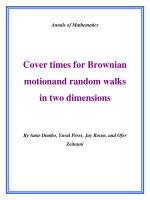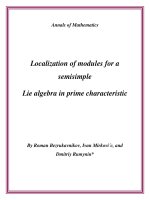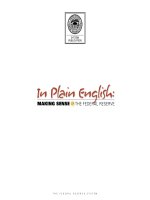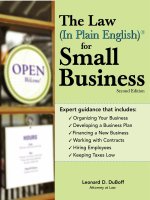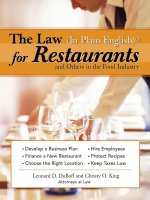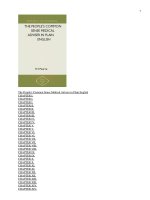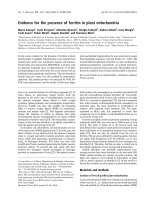GUIDELINES FOR WRITING WORK METHOD STATEMENTS IN PLAIN ENGLISH pdf
Bạn đang xem bản rút gọn của tài liệu. Xem và tải ngay bản đầy đủ của tài liệu tại đây (609 KB, 24 trang )
New South Wales Government
GUIDELINES FOR WRITING
WORK
METHOD STATEMENTS IN PLAIN ENGLISH
WorkCover. Watching out for you.
GUIDELINES
FEBRUARY 1998
BUILDING AND CONSTRUCTION INDUSTRY
Disclaimer
This publication may contain occupational health and safety and workers compensation information. It may include some of your obligations under the
various legislations that WorkCover NSW administers. To ensure you comply with your legal obligations you must refer to the appropriate legislation.
Information on the latest laws can be checked by visiting the NSW legislation website (www.legislation.nsw.gov.au) or by contacting the free hotline
service on 02 9321 3333.
This publication does not represent a comprehensive statement of the law as it applies to particular problems or to individuals or as a substitute for
legal advice. You should seek independent legal advice if you need assistance on the application of the law to your situation.
© WorkCover NSW
CONTENTS
PAGE
INTRODUCTION 2
PART A 3
Suggested proforma 4
Proforma for work method statements 6
PART B 8
Points to remember when writing work method statements in plain English 8
Seven ways to write effectively 9
1) Write out the job procedure step by step 9
2) Use active, not passive voice 10
3) Sequence ideas logically 10
4) Keep sentences short and clear 11
5) Choose words carefully 12
6) Use verbs not nouns 13
7) Consider layout and formatting 13
Alternatives to writing 14
REFERENCES 15
APPENDICES 16
Appendix 1 Formal words and long winded phrases 16
Appendix 2 Redundancies - unnecessary repetitions 18
Appendix 3 Verb forms for commonly used nouns 19
Appendix 4 Checklist - writing effective work method statements 20
1
INTRODUCTION
Why do we need work method statements?
The purpose of a work method statement is:
• tooutlineasafemethodofworkforaspecificjob
• toprovideaninductiondocumentthatworkersmustreadandunderstandbeforestartinga
job
• tomeetlegalrequirements,thatis,hazardidentificationandcontrol
• toprogramwork,materials,time,staff,andtoanticipatepossibleproblems
• touseasatoolinqualityassurance.
Remember that a work method statement is part of a site safety plan. This plan should
include:
• InductionTraining
• RegisterofHazardousSubstances
• WorkMethodStatement
• OHSProcedures
• ResponsibilitiesFlowChart
• RehabilitationPolicy.
ThereisagrowingneedforcompaniestowriteworkmethodstatementsinplainEnglish.These
procedures must be readily understood by all employees, including employees with low literacy/
numeracyskills.Theaimofthisdocumentistoprovideyouwithideasandsuggestionstohelp
youwriteworkmethodstatementsinaneasytoreadstyle,thatis,inplainEnglish.
Ifyoutaketimeandcaretoprepareclearandconcisesitespecificworkmethodstatementsyou
cansaveyourcompanyvaluabletimeandmoney.Thesesavingsreturngreaterprofits.
We hope that the suggestions in this booklet will assist writers of work method statements to
uselanguageandformattingthatisconcise,clearandeasilyunderstood.
2
PART A:
Suggested proforma
Theproformaonthefollowingpagescoversallthemainpointsrequiredbymajorcontractors
andthelaw.Initwehavesuggestedwaysoffillingineachsection.
Explaining the proforma
Writeallyourworkmethodstatementsafterconsultingtheworkerswhoaregoingtousethem.
Youmaythenneedtoredraftthemtoincludetheirsuggestions.Theymayseeabetterand
saferwayofdoingthejob.
Workers will be more willing to take ownership of the documents and act on them if they
participateinplanningandwritingthem.
WedesignedtheproformatofitA4paper.Itisdoublesided.Thisovercomestheproblemsof
havingmorethanonesheetofpapertodealwith.However,youcouldaddextrapagesifthere
isnotenoughspaceinanyonesection.
Intheproformatheprocedures,possiblehazardsandsafetycontrolsareprintedsidebyside.
Thiswillmakeiteasierforyoutoconsiderthepossiblehazardsforeachstep.Thenyoucan
decideontheappropriatecontrolstoovercomeeachhazard.
All employees should be aware that there are work method statements and that they must see
and sign them.
3
4
Signed Off: _______________________________
Date: ______________________ No: __________
Accepted: Yes / No
Work Method Statement (Part 1)
Contractor:
Project:
Job Area:
Procedure (in steps): Possible Hazards: Safety Controls:
1.
2.
3.
4.
5.
6.
7.
8.
9.
10.
11.
12.
13.
14.
15.
5
Work Method Statement (Part 2)
Personal Qualifications and Experience: Personnel, Duties and Responsibilities: Training Required to Complete Work:
Engineering Details/Certificates/WorkCover Approvals: Codes of Practice, Legislation:
Plant/Equipment: Maintenance Checks:
Read and Signed by All Employees on Site:
6
Signed Off: _______________________________
Date: ______________________ No: __________
Accepted: Yes / No
Work Method Statement (Part 1)
Contractor: Put the name of your organisation here.
Project: Put the name of the building you are working on here.
Job: Write in the task or job that you are doing. Area:
Procedure (in steps): Possible Hazards: Safety Controls:
1. Write out the job step by step Include all possible hazards such as: List all safety controls such as:
2. Start each step with an action word. For example • Hazardous substances, explosives, dust, etc • MSDS
3. •Fix hand rail to stair well walls • Manual handling, lifting heavey weights (15kg?) • Warning Signs
4. •Twisting, pushing and pulling, lifting and carrying • Personal protective equipment
5. • Hazards to others in area • Fellow workers/public safety provisions
6. •Rubbish, electrical, fills • Storage of materials and equipment
7. •Housekeeping
8.
9.
10.
11.
12.
13.
14.
15.
Work Method Statement (Part 2)
Personal Qualifications and Experience: Personnel, Duties and Responsibilities: Training Required to Complete Work:
You will need to list all the details of Give details of the duties and specific Make sure that all workers and their supervisors
qualifications and experience you and your responsibilities of supervisors and other are trained in the procedures needed to complete
workers will need for the job. Include: trade personnel. For example, describe such things as the job safely, expecially where you are using
certificates, WorkCover tickets, demolition daily safety check of the work area by leading new or changed work methods.
licences for contractor. Experience may cover hand. You might like to include on a separate
previous work done in the area that may sheet, a flow chart showing the structure of your
not require certificates or licences. organisation and include the responsibilities of
each person in that structure
Engineering Details/Certificates/WorkCover Approvals: Codes of Practice, Legislation:
Give details that might be required for demolition, precast panel erection, Are relevant codes of practice available on site? Is the work method equal
structural steel erection. Certificates may be needed for formwork – to or better than any applicable codes of practice for the job to be done?
falsework, machinery on suspended slabs, point loading on suspended Do procedures agree with relevant legislation?
slabs and WorkCover approval of machine-felling for demolition work.
Plant/Equipment: Maintenance Checks:
List plant and equipment that you use on the job, e.g. ladders, scaffold Include: maintenance on cranes, forklift, monthly check on all electrical
trestles, grinders, electrical leads and equipment, formwork materials equipment and necessary tags, etc
shoring materials, oxy set, welding machines, fire extinguishers, etc.
Read and Signed by All Employees on Site:
7
PART B:
Points to remember when writing work method statements in plain English:
“PlainEnglishisgettingaclearmessageacrosstoyouraudienceinanappropriateway.
Thismeansbeingclearaboutwhatyouwanttosay,whoyou’resayingittoandhowyou’re
goingtosayit.PlainEnglishiseffectivecommunication”.NSWAdultLiteracyCouncil
Plain English means:
• consideringthereader
• communicatingaclearmessagetothereader
• usingclear,conciselanguage
• rethinkinghowinformationispresentedsothatitattractsthereader.
Plain English does not mean:
• writinginsimpleEnglish
• usingtheminimumamountofwords
• gettingridoftechnicallanguage
• talkingdowntothereader
• losingmeaning.
Plain English has many benefits:
• Workersaremorelikelytoreadandactonwrittentexts
• Readersarelessfrustratedandviewdocumentsinamorepositiveway
• Thereislessinterruptiontoworkfromqueriesandmisunderstandings
• Documentstakelesstimetoproduce
• Safetyandqualitycanbeimproved
• Trainingiseasierandmoretimeefficient.
Audience:
Keep in mind the personnel who are going to read the work method statement and consider
these questions:
• Howwelldotheyread?(educationalbackground)
• Aretheyfromanon-Englishspeakingbackground?
8
Seven ways to write effectively:
NowwewilllookatsevenwaystowriteworkmethodstatementseffectivelyinplainEnglish.
Thesewillmakeyourworkmethodstatementseasiertowriteandunderstand.Thesevenways
to write effectively are:
1. Write out the job procedure step by step page 9
2. Use active, not passive voice page 10
3. Sequence ideas logically page 10
4. Keep sentences short and clear page 11
5. Choose words carefully page 12
6. Use verbs not nouns page 13
7. Consider layout and formatting page 13
1. Write out the job procedure step by step
Start each step with an action word.
Set it out as shown in the Procedure Section of the Suggested Proforma on page 5.
Examples
Example 1:
1. Deliverallducttothesite.
2. Storeinareassetasidebythebuilder.
3. Clearworkareaofallobstacles.
4. Joinductworkonfloorinlengthslessthanninemetres.
Example 2:
1. Locatecentreofeachhole.
2. Checkthateachholewouldonlypenetratetheslabthickness.
3. Drillan8to10mmpilothole.
4. Insertasmallwireorrodthrougheachhole.
Example 3:
1. Erect and bracecolumns.
2. Erect and bracebeams.
3. Tiebeamsandbracing.
4. Bridgepurlins.
5. Tensionbolts.
9
2. Use active, not passive voice
Use active, not passive voice. It is more personal and direct and specifies who must do
the action.
Examples:
8 Materialsmust be removedinmanageablelots.
4 Removematerialsinmanageablelots.
8 Protective gloves are to be worn.
4 Wearprotectivegloves.
8 Fork lifts must not be drivenfasterthanwalkingspeed.
4 Never driveforkliftsfasterthanwalkingspeed.
8 Leadsare to be keptabovefloorlevel.
4 Keepleadsabovefloorlevel.
8 All equipment to be checked and tested.
4 Check and testallequipment.
3. Sequence ideas logically
(i) Put the main idea first
Examples:
8 When you are working in a dusty and windy area, wearsafetyglasses.
4 Wearsafetyglasseswhenyouareworkinginadustyandwindyarea.
8 From the information on the plan, establishtherequiredwidthoftheformwork.
4 Establishtherequiredwidthoftheformworkfromtheinformationontheplan.
(ii) Put the time phrase, if important, as a sub-heading and then the instructions in point
form underneath.
Example:
When cutting, drilling or shaping glasswool insulation:
a) wear protective clothing
b) use a suitable dust mask
c) avoidcontactwithyoureyes.
(iii) Try to put information in point form for clear and easy reading.
Example:
8 When compressed air jack hammers are to be employed for the purpose of excavation,
it is advisable to make certain that the air compressor is placed within as close a
proximity as practicable to the worksite and all equipment is to be fitted with suitable
apparatusfornoiseabatement.Hearingprotectionistobewornbyallemployeesatall
times and air hoses are to be fitted with snap-on safety couplings which are to be fixed to
thehosebytheuseofsafetylockingpins.
10
4 When using jack hammers for excavation work:
a) place the compressor as close to the work as possible
b) make sure that the equipment is fitted with noise controls
c) wear hearing protection
d) use snap-on safety couplings on all hoses
e) fixsafetycouplingswithsafetylockingpins.
(iv) Separate any extra information that may be needed to make the instruction clear. Do this
by putting the extra information in a highlighted box or by using italics.
Example:
Blockofffixedtypelaserbeamsbyusingabeamstop.
Safety Note
Effectivebeamstopshaveamattfinishtostopreflection.Earth,wood,plywood,brick,
mortar,concreteorplasterboardsurfacesaresuitable.
Roughenthesurfaceofmetalbeamstops.
(v) Use parallel structures - that is use the same grammatical structure to express similar
ideas or two or more ideas in the same sentence.
Example:
8 Topreventfalls:
• fix solid one metre high guard rail
• workers must use a safety harness
• workers wearing safety footwear
• securelycovering all floor penetrations
4 Topreventfalls:
• fix solid one metre high guard rail
• use safety harness
• wear safety footwear
• coverallfloorpenetrationssecurely.
4. Keep sentences short and clear
Remember:
a) Long and/or complex sentences are more difficult to understand. They take longer to
read and can hide information.
b) A sentence should contain only one or two ideas. Separate ideas with lists, dot points
and punctuation (commas, semi-colons, colons).
c) If you must have a long sentence (more than 18 words), follow it with a short one.
11
Example:
8 Thetrainerwillensurethateachcranedriver/chaserisfullyskilledinliftingprocedures
and, most importantly, will confirm that each crane driver/chaser fully understands what his
dutiesare.
4 Trainersmustmakesurethatcranedrivers/chasers:
a) know correct lifting procedures
b) fullyunderstandtheirduties.
5. Choose words carefully
(i) Don’t use too many formal words or long winded phrases. (See Appendix 1)
Examples:
8 ensure
4 make sure
8 accordingly
4 so
8 without further delay
4 immediately
8 at this point in time
4 now.
(ii) Avoid unnecessary repetition or redundancies. (See Appendix 2)
Examples:
8 Power to the construction site is available on an around the clock basis.
4 Powertotheconstructionsiteisavailable24hoursaday.
(iii) Do not use too many nouns together - they can make the document difficult to
understand because the reader must take in a lot of information in a short space.
Examples:
8 safety regulation handbook
4 handbook of safety rules
8 estimated monthly attendance performance bonus
4 monthlyattendancebonus.
(iv) Avoid jargon, slang, idioms, sexist or racist terms, and foreign expressions.
Examples:
a) chippie, sparky, gofer
b) I’mbroke
c) as slow as a snail
d) foreman
e) déjàvu.
12
(v) Do not use contractions (short forms). They are not as strong as the words written in
full.
Example:
8 Don’t
4 Donot.
(vi) Beware of acronyms (words made from initials) - you must explain what they mean the
first time you use them.
Example:
Construction,Forestry,MiningandEnergyUnion(CFMEU).
(vii) Spell out abbreviations to avoid confusion whenever possible. If you must abbreviate:
a) do so only when necessary, and
b) make sure that the abbreviations are understood.
Examples:
8 e.g.
4 for example
8 i.e.
4 thatis.
(viii) Spell out one, two, three, four, five, six, seven, eight, nine and ten. Over ten, use
numbers -11,12,13
(ix) Use spelling from the Macquarie Dictionary. It is the most suitable for Australia.
6. Use verbs not nouns
Be careful of turning verbs into nouns (nominalisation). This makes the document “heavy”
or “academic” and hard to read.
(See Appendix 3 for a list)
Examples:
8 Utilisation of backhoes on construction sites must only be done in consultation with
supervisor.
4 Consult supervisors before usingbackhoesonconstructionsites.
8 Failure to comply with these directives will result in expulsion from this facility and/or
notificationoftheconstructioncompany.
4 We will expel you from this site and notify the construction company if you do not
complywiththesedirectives.
7. Consider layout and formatting
• Keep your layout open.Useplentyofwhitespace.Thismakestheproceduremore
readable.
• Use no more than two separate font styles: one Bold and the other Italic.Ifyouuse
more,thefinishedproductwillnotpresentwell.
13
• Avoid using CAPITALS to write full words-THEYAREMOREDIFFICULTTOREAD.
• Do not use underlining.Makeimportantheadingslargerinstead.
• Justify (line up) the text to the leftasthishelpsyoutoreadthedocumentmoreeasily.
• Use a serif rather than a sans serif font.Again,itiseasiertoread.
For example:
8 Supply eye protectors to operators, other workers and visitors where there are eye
hazards.Alwaysweareyeprotectors.
4
Supply eye protectors to operators, other workers and visitors where there are eye
hazards. Always wear eye protectors.
• Learn how to use your keyboard to its full capacity.Therearemanyfeaturesthatcan
beusedtogiveamoreprofessionalfinish.
• Take care with the length of lines.50-70charactersistheidealnumberofcharacters
perline.
• Use subheadings to help break up large blocks of text and guide the reader to the
information.
• Use colour sparingly.Itishardertoreadthanblackandwhite.
• Make sure graphics are easy to understand.
• Keep layout consistentthroughoutthedocument.
• If you need to include a glossary of technical terms make sure that you follow the
agreed layout.
Finally, get somebody who does not know the job to read the work method statement.
You have achieved a satisfactory result if they understand it.
Alternatives to Writing:
Itisveryimportanttoconsideralternativestowritingifyouhaveemployeeswhohavereading
problems.Theymaynotbeabletoreadwordsbuttheymaybeabletofollowapicture,a
diagramorspokeninstructions.
Use alternatives to writing if these convey the meaning more easily:
• Flowchartsforwritingworkinstructionsandprocedures,explainingprocesses,defining
production goals
• Diagrams,illustrations,graphics,linedrawingsfortechnicalterminologyandprocedures
• Tables,charts,graphs(pie,vertical,lineetc.)forstatistics,productiondataandfigures
• Mapsforemergencyprocedures,locationsandlayoutofareas.
Or
Read the work method statement to employees and check that they have understood it. Make
sure that they then sign it.
14
REFERENCES
Aldhamland,M.,EditingandPublishingWorkshopforAMES,1995
Bousaleh,Gail,‘GuidelinesforWritingintheWorkplace’,AMESEWP,1992
Burke,T.,MeLeod,J.,Montgomery,G.andRiley,M.,Plain English Writing Project,NSW
TAFE,1989
Cole,K.,Crystal Clear Communication,PrenticeHall,Sydney,1993
DEET,Reader Friendly Documents Kit - Profit and Popularity with Plain English, Sydney, 1995
Eagleson,R.D.,Writing in Plain English, AGPS Press, Canbeffa, 1990
Guffey,M.E.,Essentials of Business Communication, KWS, Boston, 1991
Kidd,Isobel,WorkshoponWritingProceduralandFactualTextsinPlainEnglish,AMES1995
Lammas,Brian,“GettingtheMessageAcross”,EnglishInTheWorkplace,AMES,1994
MasterBuilders’AssociationandSummerHillFilms,Stop Chasing Your Tail, WorkCover,
Sydney, 1996
Middleton,R.,andBell,J.,“WritingStandardOperatingProceduresinPlainEnglish”,AMES,
1996
Nenke,Margaret,“WritingStandardOperatingProceduresinPlainEnglish”,SouthernCopper,
AMES/EWPWollongong,1995
Patterson,Sue,“MadeToMeasure,Language,LiteracyandNumeracyinTCFIndustryTraining’,
AMES,Sydney,1996
Street,Suzanne“PlainEnglishWorksheets”,AMESEnglishintheWorkplace,1994
SydneyElectricity,“StyleGuideforElectricalSafetyRulesWritingProject”,AMES,1995
Walsh,B.,Communicating in Writing, 2nd Edition, AGPS Press, Canberra, 1989
Watson,Jacqui,andLewis,Joanna,“AGuidetoPlainEnglishWritingintheWorkplace”,
AMES,1996
15
APPENDICES
Appendix 1
Formal words and long winded phrases
Use these instead of these
no absence of
so, therefore accordingly
follow adhere to
changes adjustments
manage administer
give, divide allocate
clear, plain apparent
when necessary as applicable
later at a later time
always at all times
now at the present time
because because of the fact that
by by means of
since, because by virtue of the fact
work out calculate
start commence
complete complete in all respects
has contain
now currently
make less, reduce decrease
despite despite the fact that
shown described herein
stop, end discontinue
send dispatch
because, since due to the fact that
length of duration of
inside, within encase
exit egress
make sure ensure
work out estimate
check examine
leave out exclude
show, tell explain
for for the purpose of
16
Use these instead of these
because for this reason
later further down the track
need have to
causing giving rise to
same identical
at once immediately
according to in accordance with
and in addition
with in conjunction with
about in reference to
about regarding
finally in the final analysis
soon in the near future
now in this day and age
considering in view of
if in the event that
look at, check inspect
tell notify
see, adhere to, obey observe
regularly on a regular basis
before prior to
part portion
rules, ways procedures
why reason for
fix rectify
move relocate
need, want, must require
needing requiring
must required to
must shall
to so as to
after subsequent to
job task to be performed
the kind of the nature of
use utilise
when whilst, while
could, might with a potential to
immediately without further delay
17
APPENDIX 2
Redundancies - unnecessary repetitions
Use these instead of these
essential absolutely essential
adequate adequate enough
warning advance warning
fundamentals basic fundamentals
big biginsize
combined combined together
eliminate completely eliminate
component component part
consensus consensus of opinion
continue continue on
cooperate cooperate together
each each and every
result end result
identical exactly identical
outcome final outcome
thanks grateful thanks
few few in number
green hat green coloured hat
inventory inventory stock
cooperation mutual cooperation
action required necessary action required
prerequisite necessary prerequisite
beginning new beginning
first hand on a first hand basis
history past history
period period of time
reason reason why
red red in colour
refer refer back
repeat repeat again
schedule time schedule
little tiny little
total total and utter
facts true facts
18
APPENDIX 3
Verb forms for commonly used nouns
Use these verbs instead of these nouns
anchor anchorage
act action
alter alteration
apply application
analyse analysis
assess assessment
assist assistance
attach attachment
complete completion
comply compliance
connect connection
construct construction
erect erection
examine examination
expose exposure
fail failure
identify identification
improve improvement
inform information
install installation
isolate isolation
investigate investigation
maintain maintenance
organise organisation
place placement
position positioning
prepare preparation
project projection
protect protection
recognise recognition
reduce reduction
reject rejection
remove removal
specify specification
supervise supervision
terminate termination
train training
vary variation
19
APPENDIX 4 - CHECKLIST
Check List - Writing Effective Work Method Statements
Have you: Yes/No Comments
keptyoursentencesshortandclear?
• eliminatedunnecessarywords
• avoidedusingtoomanyclausesina
sentence
usedactivenotpassivevoice?
sequencedyourinformationlogically?
chosenyourwordscarefully?
• usedwordsfamiliartoemployees
• usedconsistentlanguage
• avoidedusingidioms
• explainedacronymsandabbreviations
• definedtechnicalwords(usedaglossary)
• standardisedmodality(must,should)
usedverbsnotnounsforactions?
avoidedusingstringsofnouns?
consideredalternativestowriting?
• diagrams,graphics,charts,tables,maps,
flow charts
followedtheagreedformat?
• layout
• styleguide
observedcopyrightlaws?
• acknowledgedsources
20
WorkCover Offices
For all occupational health and safety, workers compensation and rehabilitation information, call the WorkCover
Information Line – 13 10 50 from anywhere in New South Wales.
HEAD OFFICE
Office Hours 8:30am – 5:00pm
Monday to Friday
92–100 Donnison Street
GOSFORD 2250
Phone (02) 4321 5000
Fax (02) 4325 4145
Postal Address
WorkCover NSW Locked Bag 2906
Lisarow NSW 2252
WorkCover Assistance Service
Office Hours 8:30am – 4:30pm
Monday to Friday
92–100 Donnison Street
GOSFORD 2250
Phone 13 10 50
LABORATORIES
Thornleigh
5A Pioneer Avenue
THORNLEIGH 2120
Phone (02) 9484 6655
Fax (02) 9980 6849
Londonderry
TestSafe Australia
Ground Floor 919 Londonderry Road
LONDONDERRY 2753
Phone (02) 4724 4900
Fax (02) 4724 4999
REGIONAL and LOCAL OFFICES
Office Hours 8:30am – 4:30pm
Monday to Friday
REGIONAL OFFICES
Newcastle
956 Hunter Street
NEWCASTLE WEST 2302
Phone (02) 4921 2900
Fax (02) 4921 2929
Wollongong
106 Market Street
WOLLONGONG 2500
Phone (02) 4222 7333
Fax (02) 4226 9087
LOCAL OFFICES
Albury
463 Kiewa Street
ALBURY 2640
Phone (02) 6021 5911
Fax (02) 6041 2580
Batemans Bay
Shop 6, Fenning Place
12 Orient Street
BATEMANS BAY 2536
Phone (02) 4472 5544
Fax (02) 4472 5060
Blacktown
125 Main Street
BLACKTOWN 2148
Phone (02) 9671 8701
Fax (02) 9831 8246
Dubbo
Suite 3, 157 Brisbane Street
DUBBO 2830
Phone (02) 6884 2799
Fax (02) 6884 2808
Goulburn
21–23 Clifford Street
GOULBURN 2580
Phone (02) 4822 1243
Fax (02) 4822 1242
Grafton
NSW Government Offices
49–51 Victoria Street
GRAFTON 2460
Phone (02) 6641 5111
Fax (02) 6641 5100
Griffith
NSW Government Offices
104–110 Banna Avenue
GRIFFITH 2680
Phone (02) 6964 2027
Fax (02) 6964 1738
Hurstville
Level 4, 4-8 Woodville Street
HURSTVILLE 2220
Phone (02) 9598 3366
Fax (02) 9585 0261
Lindfield
345 Pacific Hwy
LINDFIELD 2070
Phone (02) 9936 3000
Fax (02) 9936 3030
Lismore
Suite 4, Level 4
Manchester Unity Building
29 Molesworth Street
LISMORE 2480
Phone (02) 6622 0088
Fax (02) 6622 0090
Liverpool
Suite 4, Ground Floor
157–161 George Street
LIVERPOOL 2170
Phone (02) 9827 8600
Fax (02) 9827 8690
Narrabri
Level 1, 55 Maitland Street
NARRABRI 2390
Phone (02) 6792 4643
Fax (02) 6792 3532
Newcastle
956 Hunter Street
NEWCASTLE WEST 2302
Phone (02) 4921 2900
Fax (02) 4921 2929
Orange
74 McNamara Street
ORANGE 2800
Phone (02) 6361 7070
Fax (02) 6362 8820
Parramatta
Level 4, 128 Marsden Street
PARRAMATTA 2150
Phone (02) 9841 8550
Fax (02) 9841 8490
Port Macquarie
Shops 1 & 2,
Raine & Horne House
145 Horton Street
PORT MACQUARIE 2444
Phone (02) 6584 1188
Fax (02) 6584 1788
Shellharbour
134–134A Lamerton House
Shellharbour Square
BLACKBUTT 2529
Phone (02) 4297 3796
Fax (02) 4296 8914
Tamworth
Shop 20, 341 Peel Street
TAMWORTH 2340
Phone (02) 6766 2490
Fax (02) 6766 4972
Lake Macquarie
Shop 2, 33 The Boulevarde
TORONTO 2283
Phone (02) 4959 6366
Fax (02) 4950 5587
Tweed Heads
Suite 5, 1 Sands Street
TWEED HEADS 2485
Phone (07) 5536 3262
Fax (07) 5536 4389
Wagga Wagga
Level 2, 76 Morgan Street
WAGGA WAGGA 2650
Phone (02) 6937 3600
Fax (02) 6937 3616
Wollongong
106 Market Street
WOLLONGONG 2500
Phone (02) 4222 7333
Fax (02) 4226 9087
Catalogue No. WC00231 WorkCover Publications Hotline 1300 799 003
WorkCover NSW 92-100 Donnison Street Gosford NSW 2250
Locked Bag 2906 Lisarow NSW 2252 WorkCover Assistance Service 13 10 50
Website www.workcover.nsw.gov.au
ISBN 0 7310 8768 2 ©Copyright WorkCover NSW 0508

